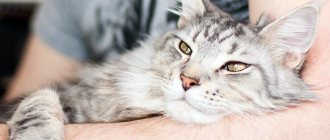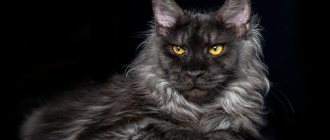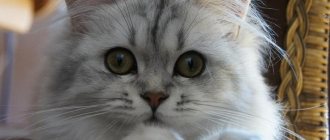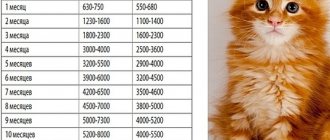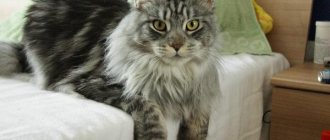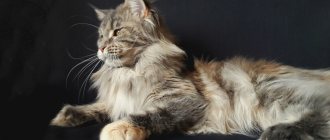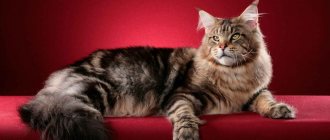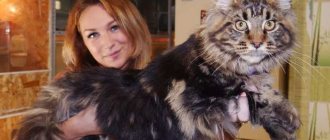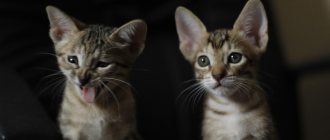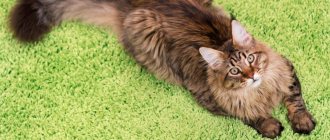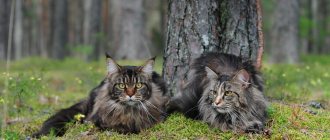The Norwegian Forest Cat is a long-haired breed, especially popular in Scandinavia and Northern Europe. Breeders and fanciers affectionately call these cats Norwegians, and in their homeland in Norway they are called “skogkatt”; they are proud of their furry pets as a national treasure. These cats are a combination of the beauty and grace of a domesticated predator.
Who's Who of the "Aborigines"
Three native breeds of semi-long-haired cats were formed in different parts of the globe - all the more surprising are the obvious similarities between them. Coons, Siberians and Norwegians have similar appearance features that go back to wild forest cats, so the question of how to distinguish a Maine Coon from other cats of this type is not idle. No wonder, according to one legend, because of the tufts on their ears and high cheekbones, Maine Coons are considered descendants of the lynx, and in the round-headed representatives of the Siberian breed they perceive a resemblance to the Pallas's cat. The Kurilian Bobtail has an obvious difference from the three other aboriginal breeds - a short tail, but in terms of other breed characteristics (constitution, coat, head structure) it is very close to them.
- Maine Coons are surrounded by many legends. Among their ancestors are raccoons, lynxes, long-haired pets of the executed Queen Marie Antoinette, as well as Captain Cook’s personal cats. Maine Coons are actually descended from Maine's working mouse-catching farm cats, adapted to the harsh climate of the American Northeast. The breed was registered in 1895. Unfortunately, in the first half of the 20th century, interest in giants diminished (coons seemed rustic compared to the exotic Persian cats), and talk about the extinction of the breed began, but already in the 1970s, the triumphant return of Maine Coons began. Nowadays, the breed is being actively renewed; two types of Maine Coons are being formed - European (extreme) and American (traditional).
- The Norwegian Forest Cat comes from animals that belonged to the ancient Vikings. The first systematic description of the breed dates back to 1912, but then the number of its representatives began to decrease. Active breeding work to preserve forest cats began in the 30s of the twentieth century. The breed standard for the Norwegian Forest Cat was approved in 1977.
- The Siberian cat
is a young breed; the standard was developed in 1987. The breed is in its infancy; often different types of animals are classified as Siberians, so the issue of a unified standard for Siberian cats is still on the agenda.
Features of behavior
European forest cats are very careful, they can even be called shy. This often leads to manifestations of aggression towards strangers. These cats especially avoid human settlements and try not to be seen by people at all. In general, they prefer not to enter into conflicts with their relatives or with any other predators.
They live alone. An adult male is able to control a forest area of up to three square kilometers. To mark boundaries, the cat leaves marks from physiological secretions and claw marks on tree trunks. Therefore, strangers rarely wander into its territory.
The European forest cat has many natural enemies - lynx (Lynx), large steppe cat, jungle cat (Felis chaus), fox (Vulpes Vulpes), gray wolf (Canis lupus), jackal (Canis aureus), marten (Martes martes), bear (Ursus arctos). In Tajikistan, the wolf is the most serious competitor for the Forest cat; quite frequent destruction of cat holes is observed here. Birds of prey, including the Eurasian eagle owl (Bubo bubo) and saker falcon (Falco cherrug), are often quite successful at preying on cat kittens. Naturalist Seton Gordon recorded an incident where a Forest cat fought with a golden eagle (Aquila chrysaetos), resulting in the death of both parties.
The animal spends most of the daytime in a den, most often built in an old hollow in a large tree. Tree hollows usually contain enough sawdust, so the cat does not make additional bedding. If fleas appear in the den, the Steppe cat moves to another place. In winter, when snowfall prevents the cat from traveling long distances, it remains in its shelter until the climatic conditions for movement improve.
Those individuals that live in the mountains make rookeries in rock crevices or abandoned burrows of badgers (Meles meles) and foxes (Vulpes Vulpes). They are small depressions under cliffs, dense accumulations of branches; for Wild cats this is not only a den, but also a temporary shelter in times of danger.
Crevices in rocks or holes, equipped as shelters, are lined with dry grasses and bird feathers.
In the floodplains, animals choose wide forks of trees and abandoned nests of large birds, such as herons, for shelter and resting places.
The predator goes out for prey at night, several hours before dawn. But in winter conditions it practices additional hunting early in the morning and late in the evening.
European forest cats living in floodplains control up to one or two hectares of territory, but during the mating season, males can leave the boundaries of their territory in search of females.
The European forest cat is capable of moving very quickly when pursuing prey or escaping from pursuit, and is an excellent climber of trees and low rocks.
The animal has excellent hearing and vision, and a slightly lower level of smell. It is silent, but capable of making low and hoarse meowing sounds, and can purr, snort, purr, and hiss.
Due to the large number of enemies in the forest, from which, however, the predator is able to instantly hide in trees and rock crevices, the appearance of the beast is associated with a gloomy and wary creature. Nevertheless, this is one of the most beautiful and noble animals in the world, somewhat reminiscent of an exotic domestic cat.
How to distinguish Maine Coons from “Norwegians” and “Siberians”
The current standards of felinological organizations define how to distinguish a Maine Coon from a Norwegian or Siberian cat according to established parameters.
- Maine Coons are the tallest of the native breeds, they have developed bones and a long body. Unlike massive Siberian cats with a wide back and croup, Maine Coons do not appear heavy and squat. Norwegians are not as large as Coons, but their thick coat gives them bulk.
- The Maine Coon's head looks angular due to prominent cheekbones and a square muzzle with a pronounced "box". The Norwegian cat's head resembles an equilateral triangle with smooth outlines, while the Siberian's head resembles a wide inverted trapezoid.
- The Maine Coon's trademark is its large ears with tufts, set straight and high. The Siberian cat's ears are small, but wide at the base, they are tilted forward. The Norwegian cat's ears continue the triangular outline of the animal's head.
- Maine Coons have wide-set, oval-shaped eyes. Cats of the Norwegian breed have larger and more rounded eyes than Coons, and they are set at a greater angle than other breeds. Siberian cats are characterized by the classic round shape of widely spaced eyes.
- The coats of the three “wild forest” breeds also differ. The Maine Coon has a coat with a moderate undercoat, a silky thick coat and fine outer coat. The coat of representatives of this breed evenly lengthens from the shoulders to the croup. Norwegian cats are distinguished by their water-repellent outer coat and soft undercoat. The wool of Siberians is subject to seasonal changes - in summer the undercoat is short, in winter it becomes long and very dense. The outer coat of Siberian cats is hard, thick and shiny; it covers the sides like a cloak. All native semi-long-haired breeds grow sideburns, collars and “pants” during the cold season.
- For Maine Coons, Norwegian and Siberian cats, any colors are allowed, except lilac, cinnamon, chocolate, fawn and sepia. Color points are also not recognized (the standards of some felinological organizations make an exception for Neva Masquerade cats). Preference is given to natural tabby colors.
Diseases and health problems
Evolution and natural selection in conditions of constant frost have formed good immunity in the Norwegian breed. Human intervention in this process made its own adjustments. These cats are prone to a number of diseases:
Restructive cardiomyopathy. Deterioration in the elasticity of the muscle tissue of the heart, as a result of which heart failure develops, which can cause the death of the animal.- Diabetes and other endocrine system disorders.
- Arthrosis of the hip bones.
- Retinal dysplasia. It is an abnormal formation of the structure of the layers of the retina, which occurs in the prenatal period.
- Chronic renal failure.
- Glycogenosis. The disease disrupts metabolic processes in the liver. Typically, kittens with this disease are born dead or nonviable. Some individuals can live up to 4-6 months.
- Purivate kinase deficiency. A decrease in the number of red blood cells in the blood and the development of anemia.
The last two diseases are rare. Professional breeders, in order to avoid such consequences, conduct special blood tests, and are also picky about the choice of partners for mating.
If an animal receives proper nutrition and timely vaccination, the average life expectancy of an animal approaches 15-17 years.
Video how to distinguish a Maine Coon
—Tags
—Categories
- Administrative
